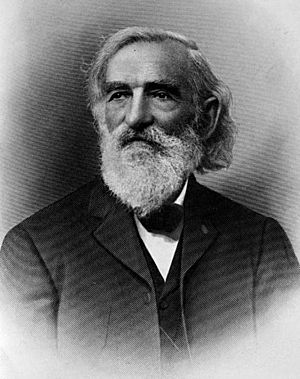John Milton Hawks facts for kids
John Milton Hawks (born November 26, 1826 – died April 2, 1910) was a very important person in American history. He was an abolitionist, which means he worked to end slavery. He was also a surgeon, a doctor who performs operations. During the U.S. Civil War, he helped formerly enslaved people and Black soldiers.
After the war, during a time called Reconstruction, he was a leader in Volusia County, Florida. He also worked for the Florida government. A special plaque honors him in Edgewater, Florida. John Milton Hawks wrote a book about Florida's east coast. He is known as a Great Floridian for his contributions to the state. His wife, Esther Hill Hawks, was also a doctor. She helped teach Black soldiers and their families.
Besides being a doctor, Hawks was an author, a historian, and a teacher. He even published a newspaper. He was an army officer and grew oranges. He was the first leader of Volusia County Schools. He also founded a place called Hawks Park, which is now known as Edgewater Park. Esther's diary was found in 1975. It was published as A Woman Doctor's Civil War: Esther Hill Hawks' Diary. This book tells about her life before they moved to Florida.
Contents
Early Life and Education
John Milton Hawks was born on November 26, 1826. His family lived in Bradford, New Hampshire. His parents were Colburn and Clarissa Brown Hawks. When he was only 15, he passed the test to become a teacher. Two years later, he started studying medicine. He also taught school in Georgia at that time. He earned his medical degree in 1847. Hawks worked as a doctor in Manchester, New Hampshire. He strongly believed that slavery should end.
Helping During the Civil War
When the Civil War began, Hawks volunteered to help. In December 1861, he went to South Carolina. He worked as a doctor for enslaved people who had escaped. These people lived on the Sea Islands. He started a school for them. He also helped recruit many Black soldiers for the Union Army. He became their doctor. He was one of the first people to say that enslaved people should be free. He also pushed for them to join the army. He became an Assistant Surgeon in the Union Army. He had the rank of Major. He worked with the 33rd Colored Troops.
Later, Hawks became the Surgeon for the 21st Colored Troops. After the U.S. Civil War, he worked in Jacksonville, Florida, in 1872. He treated formerly enslaved people, also called freedmen. He had supported their freedom even before the war. Hawks also pushed for the first Freedman's Savings Bank to be created. This bank helped freed slaves manage their money.
Founding Communities in Florida
In 1865, John Milton Hawks helped start a business. It was called the Florida Land and Lumber Company. Other army officers were part of this company. Their goal was to provide homes and jobs for formerly enslaved people. Hawks named the settlement for these freed people Port Orange. Some families stayed in the area. This place is now known as Freemanville. Most of the homes were near Spruce Creek. The first post office was built in 1867. Esther, his wife, taught with the Freedmen's Aid Society. She might have started the first school in Florida that welcomed all races.
The soil in the area was very sandy. This made farming difficult. Also, supplies meant for the settlement were stolen. Because of these problems, the settlement did not succeed. A report found that the people who stayed were struggling. They survived by eating roots from a plant called coontie. They also ate palmetto cabbage and fish they caught.
Later Life and Legacy
Esther continued teaching even after the settlement faced problems. But in January 1869, their new schoolhouse was burned down. In 1870, she went back to New England to work as a doctor. About 83 Black families stayed in eastern Volusia County. John Milton Hawks planted an orange grove. It was south of Port Orange on the Indian River. In 1871, he started Hawks Park. The Florida State Legislature renamed it Edgewater in 1924.
Henry Tolliver was a successful Black homesteader. He and his wife, Hannah Tolliver, owned land in Port Orange. Some of the former settlers lived on their land. This community was later called Freemanville. Henry Tolliver made molasses and grew crops. He grew corn, cotton, peas, beans, and sweet potatoes. His wife made and sold clothes.
John Milton Hawks passed away on April 2, 1910. He was buried in Hawks Park Cemetery. This cemetery is in Volusia County. It was later renamed Edgewater New Smyrna Cemetery. It is now in Edgewater, Florida. There is also a monument for John and Esther in Pine Grove Cemetery. This cemetery is in Manchester, New Hampshire.
Images for kids



